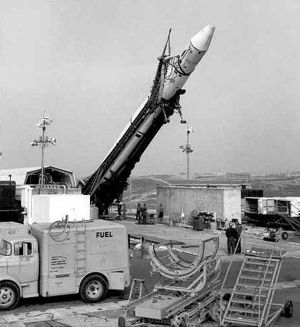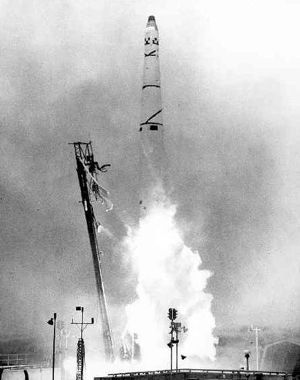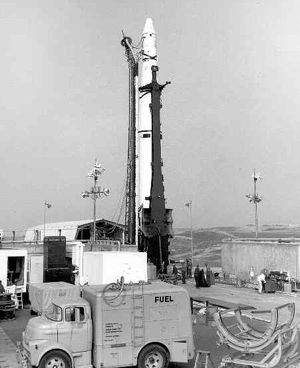
Home - Search - Browse - Alphabetic Index: 0- 1- 2- 3- 4- 5- 6- 7- 8- 9
A- B- C- D- E- F- G- H- I- J- K- L- M- N- O- P- Q- R- S- T- U- V- W- X- Y- Z
Thor Agena A
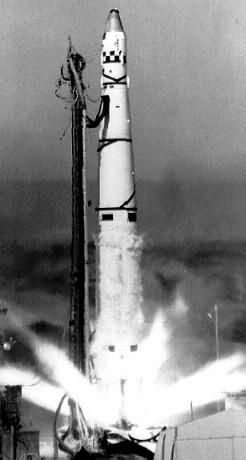 Thor-Agena A Credit: US Air Force |
Status: Retired 1960. First Launch: 1959-01-21. Last Launch: 1960-09-13. Number: 16 . Payload: 250 kg (550 lb). Thrust: 667.20 kN (149,993 lbf). Gross mass: 53,130 kg (117,130 lb). Height: 28.00 m (91.00 ft). Diameter: 2.44 m (8.00 ft). Apogee: 1,000 km (600 mi).
LEO Payload: 250 kg (550 lb). Flyaway Unit Cost 1985$: 10.730 million.
Stage Data - Thor Agena A
- Stage 1. 1 x Thor DM-19. Gross Mass: 49,340 kg (108,770 lb). Empty Mass: 3,125 kg (6,889 lb). Thrust (vac): 758.711 kN (170,565 lbf). Isp: 282 sec. Burn time: 165 sec. Isp(sl): 248 sec. Diameter: 2.44 m (8.00 ft). Span: 2.44 m (8.00 ft). Length: 18.42 m (60.43 ft). Propellants: Lox/Kerosene. No Engines: 1. Engine: LR-79-7. Status: Out of Production.
- Stage 2. 1 x Agena A. Gross Mass: 3,790 kg (8,350 lb). Empty Mass: 885 kg (1,951 lb). Thrust (vac): 68.950 kN (15,501 lbf). Isp: 276 sec. Burn time: 120 sec. Diameter: 1.52 m (4.98 ft). Span: 1.52 m (4.98 ft). Length: 4.73 m (15.51 ft). Propellants: Nitric acid/UDMH. No Engines: 1. Engine: Bell 8048. Other designations: RM-81. Status: Out of Production.
Historical Essay © Andreas Parsch
Lockheed RM-81 Agena
The Agena space vehicle was used in large numbers during the 1960s and 1970s as upper stage with SLV-2 Thor, SLV-3 Atlas and SLV-5 Titan boosters to launch a variety of military and civilian payloads into orbit. The Agena itself was actually the first general-purpose satellite, and formed the core for many operational satellites and experimental space vehicles. It is included in this missile directory, because the U.S. Air Force allocated the formal missile designator RM-81 to the Agena (see section on RM-81 Designation for details).
In 1955, the U.S. Air Force began its Weapons System 117L program, calling for the development of a strategic satellite system. The initial primary goal of WS-117L was the development an orbital photo-reconnaissance platform, and in October 1956, Lockheed became prime contractor for the system. The core element of WS-117L was a new multipurpose spacecraft with boost and manoeuvering engines, which would act as the second stage of the launch vehicle as well as the carrier vehicle for the reconnaissance system. Lockheed's Agena spacecraft was built around the Bell XLR81 liquid-propellant rocket engine, and was initially known informally as Hustler, because the XLR81 was originally developed for a (later cancelled) rocket-powered weapons pod for the B-58 Hustler bomber. The first launch of a Thor-Agena combination in January 1959 was a failure, but on 28 February that year, Agena scored its first success when a Thor-Agena launcher placed the Discoverer 1 satellite into polar orbit.
Agena A
The first few Agenas, including the vehicle used in the Discoverer 1 launch, used a Bell XLR81-BA-3 rocket engine, but most vehicles of the initial Agena A series used an XLR81-BA-5 (Bell Model 8048). The engine had gimballed nozzles for pitch and yaw control, and could deliver a thrust of 68.9 kN (15500 lb) for up to 120 s.
| Launch Vehicle Combination | Number of Launches | First/Last Launch |
| Thor (SLV-2) + Agena A | 16 | 21-Jan-1959 / 13-Sep-1960 |
| Atlas (LV-3A) + Agena A | 4 | 26-Feb-1960 / 31-Jan-1961 |
| Total for Agena A | 20 | 21-Jan-1959 / 31-Jan-1961 |
Launch summary for Agena A
The Thor-Agena A launched the initial reconnaissance satellites of the CORONA (publicly named Discoverer) series (KH-1 system), while the Atlas-Agena A was used for the first two launches of both the Midas (Missile Detection And Surveillance) early-warning system and Samos (Satellite and Missile Observation System) ELINT satellite series.
Agena B
The Agena B had an improved XLR81-BA-7 engine (Bell Model 8081), which could be restarted in space, and was stretched to carry much more propellant, doubling the total burn time to 240 s. Both features greatly increased the versatility of the Agena vehicle. When launched into low orbits, the Agena B had plenty of fuel left for extensive orbital manoeuvers, an important requirement for a reconnaissance platform. Later models of the Agena B used a further improved XLR81-BA-9 (Bell Model 8096) engine, which (among other changes) increased the thrust to 71.1 kN (16000 lb) by using a different type of fuel.
| Launch Vehicle Combination | Number of Launches | First/Last Launch |
| Thor (SLV-2) + Agena B | 44* | 26-Oct-1960 / 28-Aug-1964 |
| Thrust-Augmented Thor (SLV-2A/C) + Agena B | 3* | 29-Jun-1963 / 15-May-1966 |
| Atlas (LV-3A) + Agena B | 28 | 12-Jul-1961 / 21-Mar-1965 |
| Atlas (SLV-3) + Agena B | 1 | 9-Jun-1966 |
| Total for Agena B | 76 | 26-Oct-1960 / 9-Jun-1966 |
Launch summary for Agena B
* Thor variant counts slightly differ between sources, but Thor-Agena total is not in question
Most of the Thor-Agena B vehicles launched KH-series reconnaissance systems (all KH-2/3 CORONAs, and some satellites of the KH-4 CORONA and KH-5 ARGON series). The remainder included e.g. some ELINT systems of the Samos program. The Atlas-Agena B launched a variety of spacecraft, the major ones being Midas early-warning systems, Samos ELINT systems and Ranger space probes.
Agena C
The designation Agena C was reserved for a proposed enlarged variant, which was to have doubled the capability of the Agena B (most likely by doubling the fuel tank size). However, this version was not built.
Agena D
The majority of Agenas were of the final Agena D variant. This was essentially a "standardized" Agena B, which could accept a variety of payloads (in a conical payload section in the nose) and be fitted to Atlas, Thor or Titan launchers without changes to the basic Agena. The earlier Agena A/B vehicles were tailor-made for their respective payloads and launcher types. The Agena D launched a large number of military and scientific payloads, including e.g. the Gemini-Agena target vehicles used by NASA for space capsule docking experiments in 1966.
| Launch Vehicle Combination | Number of Launches | First/Last Launch |
| Thor (SLV-2) + Agena D | 22* | 28-Jun-1962 / 31-May-1967 |
| Thrust-Augmented Thor (SLV-2A/C) + Agena D | 60* | 28-Feb-1963 / 17-Jan-1968 |
| LTTAT** (SLV-2G/H) + Agena D | 22* | 9-Aug-1966 / 16-Jul-71 |
| Thorad (SLV-2G/H) + Agena D | 21* | 18-May-1968 / 25-May-72 |
| Atlas (LV-3A) + Agena D | 15 | 12-Jul-1963 / 20-Jul-1965 |
| Atlas (SLV-3) + Agena D | 48 | 14-Aug-1964 / 5-Nov-1967 |
| Atlas (SLV-3A) + Agena D | 12 | 4-Mar-1968 / 7-Apr-1978 |
| Atlas F + Agena D | 1 | 27-Jun-1978 |
| Titan 3B � (SLV-5B) | 29 | 29-Jul-1966 / 23-Oct-1970 |
| Titan 23B �� | 2 | 21-Jan-1971 / 22-Apr-1971 |
| Titan 33B �� | 3 | 21-Mar-1971 / 21-Aug-1973 |
| Titan 24B �� | 23 | 12-Aug-1971 / 21-Aug-1973 |
| Titan 34B �� | 11 | 10-Mar-1975 / 12-Feb-1987 |
| Total for Agena D | 269 | 28-Jun-1962 / 12-Feb-1987 |
Launch summary for Agena D
* Thor variant counts slightly differ between sources, but Thor-Agena total is not in question
** LTTAT = Long-Tank Thrust-Augmented Thor (quoted by some sources as identical to Thorad)
� Titan 3B was the designation for the Titan 3 + Agena D combination
�� These derivatives of the Titan 3B are sometimes called 3(23)B, 3(33B), 3(24)B and 3(34)B, respectively.
The majority of Agena D missions on Thor-type boosters launched KH-series reconnaissance systems, mostly CORONA (KH-4/4A/4B), but also ARGON (KH-5) and LANYARD (KH-6). Most of the initial Atlas-Agena D vehicles (LV-3A/SLV-3) launched GAMBIT satellites (KH-7 reconnaissance system) into orbit, but payloads also included the Mariner series of interplanetary probes and the GATV (Gemini-Agena Target Vehicle). The SLV-3A/Agena D was used to launch the CANYON and RHYOLITE/AQUACADE series of ELINT/SIGINT satellites into geostationary orbits.
The Titan 3B/23B/24B series launched GAMBIT (KH-8 reconnaissance system) satellites, while the payloads of the larger Titan 33B/34B boosters consisted of JUMPSEAT SIGINT and SDS communications satellites.
A total of 365 Agena vehicles of all types were launched into space by the U.S. Air Force and NASA between January 1959 and 12 February 1987, when the last Agena D was launched with a USAF payload (SDS communications satellite #7) as upper stage of a Titan 34B booster.
RM-81 DesignationIn 1958 (or early 1959), the U.S. Air Force allocated the formal "Research Missile" designation RM-81 to the Agena space vehicle. The reasons for this remain unclear, but the USAF possibly needed to assign a designator for formal purposes and there was no better alternative at that time. USAF serial number listings show a total order of 341 Agenas, designated as XRM-81, RM-81, SRM-81 and SRM-81A. Because I cannot connect these four designators in any way to the documented basic Agena variants (Agena A/B/D), I don't know what the significance of the different RM-81 designations is. The table below is a detailed listing of allocated Agena serial number blocks, sorted by type designation:
| Serial Range | Designation | Total Number Ordered |
| 59-2544/2557 60-606/615 60-5454/5463 60-6594/6630 60-6914/6922 62-12585 | XRM-81 | 81 |
| 60-3710/3719 | RM-81 | 10 |
| 63-7368/7406 63-12759/12764 65-10657/10685 66-4390/4432 66-9249/9262 67-14544/14579 | SRM-81 | 167 |
| 61-4530/4536 62-3876/3878 62-4614/4625 62-12202/12213 62-12289/12291 63-13040/13085 | SRM-81A | 83 |
Notes:
1. The Agena did not receive a new designation in June 1963, when the joint DOD missile designation system was introduced, because spacecraft were not originally part of the new system.
2. One would expect that SRM-81A designated a newer version than SRM-81 (before 1962, an "A" suffix designated the second version), but the latest blocks are all attributed to plain SRM-81. However, after June 1963 the Agena's designation was no longer covered by any official regulation, so it's possible that the general SRM-81 designator was not meant to designate any specific variant, but was only retained in the serial number list for informal purposes.
3. The 341 serials do not account for the full number of Agenas built (at least 365).
Note: Data given by several sources show slight variations. Figures given below may therefore be inaccurate! Because exact numbers for each Agena depend on payload configuration, the data are to be regarded as "typical" values.
Data for Agena A, Agena B, Agena D:
| Agena A | Agena B/D | |
| Length | 5.94 m (19.5 ft) | 7.56 m (24.8 ft) |
| Diameter | 1.52 m (5 ft) | |
| Weight | 3850 kg (8500 lb) Fuel: 2945 kg (6500 lb) | 7160 kg (15800 lb) Fuel: 6115 kg (13500 lb) |
| Propulsion | Bell XLR81-BA-5 liquid-fuel rocket; 68.9 kN (15500 lb) for 120 s | Bell XLR81-BA-9 liquid-fuel rocket; 71.1 kN (16000 lb) for 240 s |
[1] Jos Heyman: "World Spacecraft Digest 1957-2002", Tiros Space Information, 2003
[2] Jos Heyman: "Spacecraft Tables 1957-2002", Tiros Space Information, 2003
[3] Ren� J. Francillon: "Lockheed Aircraft since 1913", Putnam, 1987
[4] Norman J. Bowman: "The Handbook of Rockets and Guided Missiles", Perastadion Press, 1963
[5] Mark Wade: Encyclopedia Astronautica
[6] Gunter Krebs: Gunter's Space Page
[7] USAF Aircraft Serial Number Records (data provided by Jos Heyman)
More at: Thor Agena A.
Family: orbital launch vehicle. Country: USA. Engines: LR79-7, Bell 8048. Spacecraft: KH-1. Launch Sites: Vandenberg, Vandenberg SLC1W, Vandenberg SLC1E. Stages: Agena A, Thor DM-19. Agency: Douglas.
 | Thor Agena A Thor Agena A - COSPAR 1960-M |
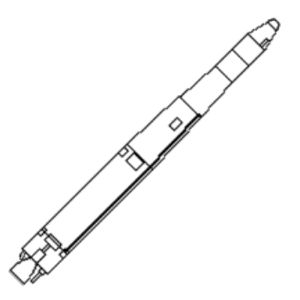 | Thor Agena A Credit: © Mark Wade |
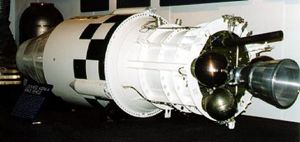 | Agena A Stage Credit: © Mark Wade |
1958 February 11 - . LV Family: Thor, Atlas, Titan, Navaho. Launch Vehicle: Thor Able, Thor Agena A.
- 14 Thor boosters to be used during year for space and ICBM missions. - .
Spacecraft: Man-In-Space-Soonest.
The ballistic missile division informed command headquarters that as many as 14 Thor boosters would be available during the calendar year for special purpose flights. These were tentatively allocated as follows: three were assigned to Phase I "Able" series flights, six were assigned to the program for recoverable satellites, and five were assigned to Phase II "Able" for continued development leading to a Thor ICBM capability. (For a time Thor plus a second stage and warhead was considered as a means of acquiring an early emergency ICBM inventory well ahead of Atlas and Titan.) However, only eight additional launchings could be scheduled through 1958--three for Phase I "Able", three for recoverable satellites to be launched one a month beginning in October, and two in support of Phase II "Able" precisely guided reentry vehicles. Thus this appeared to be the maximum effort possible in the category of space related experimental flights essential to a more advance program. If a greater effort was desirable it would be necessary to obtain additional launching facilities, a problem that might be quickly and easily solved by modifying Navaho launch stands to accept Thor vehicles. (Msg, WDT 2-7E, AFBMD to ARDC, 11 Feb 58.)
1958 March 5 - . LV Family: Thor, Atlas. Launch Vehicle: Thor Agena A, Atlas Agena A.
- USAF lead role in space reaffirmed. WS 117L to be prioritized. - .
Spacecraft: Man-In-Space-Soonest,
KH-1,
WS-117.
The Office of the Secretary of Defense, in the first significant forward step to accelerate development of a space capability, reiterated the space role of the Air Force. In addition to its missile programs the Air Force was responsible for the 117L system and "... has a recognized long term development responsibility for manned space flight capability with the primary objective of accomplishing satellite flight as soon as technology permits." Furthermore, the Air Force was told it was to carry forward and accelerate the Atlas 117L project "under the highest national priority in order to attain an initial operational capability in the earliest possible date," But the proposed interim system using a Thor booster combined with a second stage and recoverable capsule "should not be pursued. " The Department of Defense did agree that a Thor booster with a suitable second stage "may be the most promptly and readily available device for experimental flights with laboratory animals" and development of such hardware including a system for recovery of animals was authorized. (Msg 03-014, Cmdr ARDC, to Cmdr AFBMD, 5 Mar 58.)
1959 January 21 - . Launch Site: Vandenberg. Launch Complex: Vandenberg SLC1W. LV Family: Thor. Launch Vehicle: Thor Agena A. FAILURE: Launch vehicle failure.. Failed Stage: U.
- Thor Agena test - . Mass: 779 kg (1,717 lb). Nation: USA. Agency: USAF. Spacecraft Bus: WS-117. Spacecraft: KH-1. COSPAR: F590121A. First flight test of Thor-Agena for KH program..
1959 February 28 - . 21:49 GMT - . Launch Site: Vandenberg. Launch Complex: Vandenberg SLC1W. LV Family: Thor. Launch Vehicle: Thor Agena A.
- Discoverer 1 - .
Payload: KH-1 prototype / Agena A 1022. Mass: 618 kg (1,362 lb). Nation: USA.
Agency: DARPA.
Class: Surveillance.
Type: Military surveillance satellite. Spacecraft Bus: WS-117.
Spacecraft: KH-1.
Decay Date: 1959-03-03 . USAF Sat Cat: 13 . COSPAR: 1959-Beta-1. Apogee: 968 km (601 mi). Perigee: 163 km (101 mi). Inclination: 89.70 deg. Period: 96.00 min.
In the first use of a Thor as a space booster, the world's first polar orbiting satellite, Discoverer I, was launched by a Thor/Agena (Thor 163) booster combination from Vandenberg AFB. The mission was also the first successful flight test of Lockheed's Agena A upper stage vehicle designed for orbiting U.S. satellite systems. First polar orbiting satellite; KH-1 prototype; did not carry camera or film capsule.
1959 April 13 - . 21:18 GMT - . Launch Site: Vandenberg. Launch Complex: Vandenberg SLC1W. LV Family: Thor. Launch Vehicle: Thor Agena A.
- Discoverer 2 - .
Payload: KH-1 prototype / Agena A 1022. Mass: 743 kg (1,638 lb). Nation: USA.
Agency: DARPA.
Class: Surveillance.
Type: Military surveillance satellite. Spacecraft Bus: WS-117.
Spacecraft: KH-1.
Decay Date: 1959-04-26 . USAF Sat Cat: 14 . COSPAR: 1959-Gamma-1. Apogee: 346 km (214 mi). Perigee: 239 km (148 mi). Inclination: 89.90 deg. Period: 90.40 min.
An Air Force Thor/Agena A booster vehicle lifted Discoverer II into orbit from Vandenberg AFB. Discoverer II became the world's first satellite to be stabilized in orbit in all three axes, to be maneuvered on command from earth, to separate a reentry vehicle on command, and to send its reentry vehicle back to earth. The capsule ejector system malfunctioned, causing the capsule to impact near Spitsbergen on 14 April rather than near Hawaii as planned. KH-1 prototype; tested capsule recovery techniques; did not carry camera; capsule recovery failed. Because of a timing error, the US believed that the capsule landed somewhere on the island of Spitsbergen, north of Norway, instead of landing in the recovery zone near Hawaii. The capsule was never found; and CIA officials suspect it may have been snatched by the Soviets. The search for this capsule formed the basis of the book and film 'Ice Station Zebra'.
In the winter of 1960/1961, a US Discovery spy satellite capsule was found by loggers near Kalinin, 200 km north of Moscow. The loggers cracked it open with an axe. Sergei Khrushchev believed this to be the Discoverer 2 capsule. What was left was examined by Soviet engineers but didn't reveal much information - it was a polished aluminium sphere, 30 cm in diameter, gilded on the exterior. Some said it was found as early as the winter of 1959.
1959 June 3 - . 20:09 GMT - . Launch Site: Vandenberg. Launch Complex: Vandenberg SLC1W. LV Family: Thor. Launch Vehicle: Thor Agena A. FAILURE: No telemetry after Agena ignition.. Failed Stage: U.
- Discoverer 3 - . Payload: KH-1 prototype / Agena A 1018. Mass: 753 kg (1,660 lb). Nation: USA. Agency: DARPA. Class: Surveillance. Type: Military surveillance satellite. Spacecraft Bus: WS-117. Spacecraft: KH-1. Decay Date: 1959-06-03 . KH-1 prototype; did not carry camera; film capsule recovery failed..
- SRV - . Mass: 779 kg (1,717 lb). Nation: USA. Agency: USAF. Spacecraft Bus: WS-117. Spacecraft: KH-1.
1959 June 25 - . 22:47 GMT - . Launch Site: Vandenberg. Launch Complex: Vandenberg SLC1E. LV Family: Thor. Launch Vehicle: Thor Agena A. FAILURE: Insufficient stage 2 velocity.. Failed Stage: U.
- Discoverer 4 - . Payload: KH-1 9001. Mass: 743 kg (1,638 lb). Nation: USA. Agency: DARPA. Class: Surveillance. Type: Military surveillance satellite. Spacecraft Bus: WS-117. Spacecraft: KH-1. Decay Date: 1959-06-25 . COSPAR: F590625A. KH-1; 1st generation low resolution photo surveillance. Failed to achieve orbit..
- SRV 102 - . Mass: 779 kg (1,717 lb). Nation: USA. Agency: USAF. Spacecraft Bus: WS-117. Spacecraft: KH-1. COSPAR: F590625B.
1959 August 13 - . 19:00 GMT - . Launch Site: Vandenberg. Launch Complex: Vandenberg SLC1W. LV Family: Thor. Launch Vehicle: Thor Agena A.
- Discoverer 5 - . Payload: KH-1 9002 / Agena A 1029. Mass: 781 kg (1,721 lb). Nation: USA. Agency: DARPA. Class: Surveillance. Type: Military surveillance satellite. Spacecraft Bus: WS-117. Spacecraft: KH-1. Decay Date: 1959-09-28 . USAF Sat Cat: 18 . COSPAR: 1959-Epsilon-1. Apogee: 731 km (454 mi). Perigee: 214 km (132 mi). Inclination: 79.90 deg. Period: 94.10 min. KH-1; 1st generation low resolution photo surveillance; film capsule boosted into higher orbit, decayed 2/11/61. Mission failed. Power supply failure. No recovery..
- Discoverer 5 Capsule - . Payload: KH-1 9002 Capsule. Mass: 779 kg (1,717 lb). Nation: USA. Agency: USAF. Class: Surveillance. Type: Military surveillance satellite. Spacecraft Bus: WS-117. Spacecraft: KH-1. Decay Date: 1961-02-11 . USAF Sat Cat: 26 . COSPAR: 1959-Epsilon-2. Apogee: 1,700 km (1,000 mi). Perigee: 218 km (135 mi). Inclination: 78.90 deg. Period: 104.30 min. KH-1; 1st generation low resolution photo surveillance; film capsule boosted into higher orbit, decayed 2/11/61. Mission failed. Power supply failure. No recovery..
1959 August 19 - . 19:24 GMT - . Launch Site: Vandenberg. Launch Complex: Vandenberg SLC1E. LV Family: Thor. Launch Vehicle: Thor Agena A.
- Discoverer 6 - . Payload: KH-1 9003 / Agena A 1028. Mass: 783 kg (1,726 lb). Nation: USA. Agency: DARPA. Class: Surveillance. Type: Military surveillance satellite. Spacecraft Bus: WS-117. Spacecraft: KH-1. Decay Date: 1959-10-20 . USAF Sat Cat: 19 . COSPAR: 1959-Zeta-1. Apogee: 846 km (525 mi). Perigee: 207 km (128 mi). Inclination: 83.90 deg. Period: 95.10 min. KH-1; 1st generation low resolution photo surveillance; film capsule recovery failed. Mission failed. Retro rockets malfunctioned negating recovery..
1959 November 7 - . 20:28 GMT - . Launch Site: Vandenberg. Launch Complex: Vandenberg SLC1W. LV Family: Thor. Launch Vehicle: Thor Agena A.
- Discoverer 7 - . Payload: KH-1 9004 / Agena A 1051. Mass: 794 kg (1,750 lb). Nation: USA. Agency: DARPA. Class: Surveillance. Type: Military surveillance satellite. Spacecraft Bus: WS-117. Spacecraft: KH-1. Decay Date: 1959-11-26 . USAF Sat Cat: 24 . COSPAR: 1959-Kappa-1. Apogee: 820 km (500 mi). Perigee: 158 km (98 mi). Inclination: 81.60 deg. Period: 94.40 min. KH-1; 1st generation low resolution photo surveillance; satellite tumbled; film capsule not recovered. Mission failed. Failed to achieve orbit..
1959 November 20 - . 19:25 GMT - . Launch Site: Vandenberg. Launch Complex: Vandenberg SLC1E. LV Family: Thor. Launch Vehicle: Thor Agena A.
- Discoverer 8 - . Payload: KH-1 9005 / Agena A 1050. Mass: 795 kg (1,752 lb). Nation: USA. Agency: USAF. Class: Surveillance. Type: Military surveillance satellite. Spacecraft Bus: WS-117. Spacecraft: KH-1. Decay Date: 1960-03-08 . USAF Sat Cat: 25 . COSPAR: 1959-Lambda-1. Apogee: 1,661 km (1,032 mi). Perigee: 186 km (115 mi). Inclination: 80.50 deg. Period: 103.50 min. KH-1; 1st generation low resolution photo surveillance; film capsule recovery failed. Mission failed. Eccentric orbit negating recovery..
1960 February 4 - . 18:51 GMT - . Launch Site: Vandenberg. Launch Complex: Vandenberg SLC1W. LV Family: Thor. Launch Vehicle: Thor Agena A. FAILURE: Failure. Failed Stage: U.
- Discoverer 9 - . Payload: KH-1 9006. Mass: 765 kg (1,686 lb). Nation: USA. Agency: USAF. Class: Surveillance. Type: Military surveillance satellite. Spacecraft Bus: WS-117. Spacecraft: KH-1. Decay Date: 1960-02-04 . KH-1; 1st generation low resolution photo surveillance. Mission failed..
- SRV 113 - . Mass: 779 kg (1,717 lb). Nation: USA. Agency: USAF. Spacecraft Bus: WS-117. Spacecraft: KH-1.
1960 February 19 - . 20:15 GMT - . Launch Site: Vandenberg. Launch Complex: Vandenberg SLC1E. LV Family: Thor. Launch Vehicle: Thor Agena A. FAILURE: Failure. Failed Stage: U.
- Discoverer 10 - . Payload: KH-1 9007. Mass: 765 kg (1,686 lb). Nation: USA. Agency: USAF. Class: Surveillance. Type: Military surveillance satellite. Spacecraft Bus: WS-117. Spacecraft: KH-1. Decay Date: 1960-02-19 . KH-1; Mission failed..
- SRV 110 - . Mass: 779 kg (1,717 lb). Nation: USA. Agency: USAF. Spacecraft Bus: WS-117. Spacecraft: KH-1.
1960 April 15 - . 20:30 GMT - . Launch Site: Vandenberg. Launch Complex: Vandenberg SLC1E. LV Family: Thor. Launch Vehicle: Thor Agena A.
- Discoverer 11 - . Payload: KH-1 9008 / Agena A 1055. Mass: 790 kg (1,740 lb). Nation: USA. Agency: USAF. Class: Surveillance. Type: Military surveillance satellite. Spacecraft Bus: WS-117. Spacecraft: KH-1. Decay Date: 1960-04-26 . USAF Sat Cat: 32 . COSPAR: 1960-Delta-1. Apogee: 603 km (374 mi). Perigee: 166 km (103 mi). Inclination: 80.40 deg. Period: 92.20 min. KH-1; film capsule recovery failed. Mission failed. Attitude control system malfunctioned..
1960 June 29 - . 22:00 GMT - . Launch Site: Vandenberg. Launch Complex: Vandenberg SLC1W. LV Family: Thor. Launch Vehicle: Thor Agena A. FAILURE: Failure. Failed Stage: U.
- Discoverer 12 - . Payload: KH-1 prototype. Mass: 790 kg (1,740 lb). Nation: USA. Agency: USAF. Class: Surveillance. Type: Military surveillance satellite. Spacecraft Bus: WS-117. Spacecraft: KH-1. Decay Date: 1960-06-29 . KH-1 prototype; designed to test capsule recovery system; did not carry camera..
- SRV - . Mass: 779 kg (1,717 lb). Nation: USA. Agency: USAF. Spacecraft Bus: WS-117. Spacecraft: KH-1.
1960 August 10 - . 20:37 GMT - . Launch Site: Vandenberg. Launch Complex: Vandenberg SLC1E. LV Family: Thor. Launch Vehicle: Thor Agena A.
- Discoverer 13 - .
Payload: KH-1 prototype / Agena A 1057. Mass: 850 kg (1,870 lb). Nation: USA.
Agency: USAF.
Class: Surveillance.
Type: Military surveillance satellite. Spacecraft Bus: WS-117.
Spacecraft: KH-1.
Decay Date: 1960-11-14 . USAF Sat Cat: 48 . COSPAR: 1960-Theta-1. Apogee: 683 km (424 mi). Perigee: 258 km (160 mi). Inclination: 82.80 deg. Period: 94.00 min.
A Thor/Agena A launched from Vandenberg AFB placed Discoverer XIII in orbit. On 11 August, the data capsule was ejected during the 17th pass and recovered Pacific Ocean near Hawaii by a Navy helicopter that was part of the 6593d Test Squadron's task force. Although the planned mid-air recovery was not made, the return of Discoverer XIII1s data capsule marked the first successful recovery of a man-made object ejected from an orbiting satellite. KH-1 prototype; designed to test capsule recovery system; did not carry camera; capsule successfully recovered from ocean.
1960 August 18 - . 19:57 GMT - . Launch Site: Vandenberg. Launch Complex: Vandenberg SLC1W. LV Family: Thor. Launch Vehicle: Thor Agena A.
- Discoverer 14 - . Payload: KH-1 9009 / Agena A 1056. Mass: 850 kg (1,870 lb). Nation: USA. Agency: USAF. Class: Surveillance. Type: Military surveillance satellite. Spacecraft Bus: WS-117. Spacecraft: KH-1. Decay Date: 1960-09-16 . USAF Sat Cat: 54 . COSPAR: 1960-Kappa-1. Apogee: 803 km (498 mi). Perigee: 177 km (109 mi). Inclination: 79.60 deg. Period: 94.40 min. Discoverer XIV was launched from Vandenberg AFB aboard a Thor/Agena A booster.' KH-1; film capsule recovered 1.2 days later; 1st successful photosurveillance mission. First successful mission. Cameras operated satisfactorily..
1960 September 13 - . 22:14 GMT - . Launch Site: Vandenberg. Launch Complex: Vandenberg SLC1E. LV Family: Thor. Launch Vehicle: Thor Agena A.
- Discoverer 15 - . Payload: KH-1 9010 / Agena A 1058. Mass: 863 kg (1,902 lb). Nation: USA. Agency: USAF. Class: Surveillance. Type: Military surveillance satellite. Spacecraft Bus: WS-117. Spacecraft: KH-1. Decay Date: 1960-10-18 . USAF Sat Cat: 57 . COSPAR: 1960-Mu-1. Apogee: 755 km (469 mi). Perigee: 200 km (120 mi). Inclination: 80.90 deg. Period: 94.10 min. KH-1; film capsule lost at sea. Mission failed. Attained orbit successfully. Capsule sank prior to retrieval..
Back to top of page
Home - Search - Browse - Alphabetic Index: 0- 1- 2- 3- 4- 5- 6- 7- 8- 9
A- B- C- D- E- F- G- H- I- J- K- L- M- N- O- P- Q- R- S- T- U- V- W- X- Y- Z
© 1997-2019 Mark Wade - Contact
© / Conditions for Use
